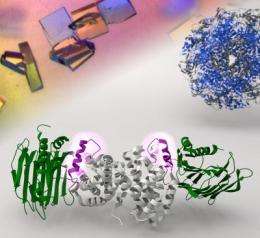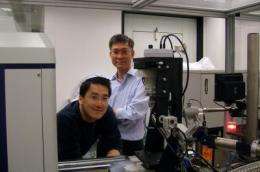Closing in on an ulcer- and cancer-causing bacterium

A research team led by scientists at the Chinese University of Hong Kong is releasing study results this week showing how a bacterium, Helicobacter pylori, that causes more than half of peptic ulcers worldwide and that has been implicated in stomach cancer has managed for eons to turn the acidic environment of the human gut into one in which it can thrive.
Writing in a Journal of Biological Chemistry "Paper of the Week," the scientists say the information they have obtained about the pathogen's clever employment of acid neutralizers may inform those who are designing new drugs to blunt H. pylori's effects across the globe.
H. pylori are the only bacteria known to thrive in the human stomach. It remains unclear how the pathogens are transmitted, although researchers suspect they could be spread through contaminated food or water. The damage the bacteria do to the mucous coating of the gut allows stomach acid to eat away at the sensitive organ lining, causing ulcers.
Although more than half of the world's population has the infection, for reasons still not quite understood most never develop ulcers. In fact, existing antibiotics can cure 80 to 90 percent of ulcers caused by the pathogen. However, H. pylori over the years have become increasingly resistant to antibiotics. Some experts have attributed that resistance to the fact that doctors are quick to prescribe antibiotics to kill it even when patients show no symptoms.
"There is a pressing need to develop new drugs and alternative strategies to fight against H. pylori infection before the prevalence of antibiotic resistance gets out of hand," says Ivan Fong, the lead author on the JBC paper and a graduate student at the Chinese University of Hong Kong whose research is focused on the biochemical makeup of protein complexes that assist in H. pylori's survival.

It's the pathogen's ability to persist within the acid bath in the human stomach that has made it such a successful, albeit harmful, vector, says Fong. "The key is its use of an enzyme called urease to neutralize gastric acid," he explains.
H. pylori produce urease to spur the breakdown of urea, a naturally occurring chemical in the body, so that urea can release ammonia and make the gut an environment in which the pathogens can thrive. But, unlike most other enzymes, urease doesn't start doing its job immediately after being produced by the bacterium; instead, two nickel ions have to be delivered to it, and then the enzyme can mature, so to speak, and thus allow H. pylori to begin their damaging work.
"As the survival of H. pylori depends on active urease, this is a life-or-death issue for the pathogen to ensure nickel ions are delivered to the urease," says Kam-Bo Wong, a professor who oversaw the project at the institution.
It's not entirely clear how H. pylori make sure that urease can mature and then neutralize the surrounding acid. But Wong's team focused on four proteins that they suspect are helpers: UreE, UreF, UreG and UreH.
Using X-ray crystallography, "which essentially performs the function of a molecular microscope to visualize proteins with atomic resolution," Fong explains, the team took snapshots of UreF and UreH. What they saw was that UreH morphs the shape of UreF to enable UreF to recruit a third player, UreG, to form the UreF-UreH-UreG complex. In other words, the three proteins hook up to collectively deliver nickel ions to the right place on urease. Once the nickel ions are in place, they serve like a flint to ignite the breakdown of urea into ammonia, which then neutralizes the stomach acids.
"So, now we have a better understanding of how the machine can assemble itself, as if a skillful mechanic were there for the job, and deliver the nickel ions," says Fong.
Importantly, the team also discovered that disrupting the formation of the crafty UreF-UreH-UreG complex does, in fact, inhibit the synthesis of active urease. They hope that the information they've obtained about the molecular structures of UreF and UreH will help in the design of drugs that will essentially muck up the works of the molecular machine.
"As active urease is the key to survival of H. pylori, designing drugs that target this complex may well be a viable strategy to eradicate the pathogen," says Wong.
More information: The abstract for the paper, titled "Assembly of the preactivation complex for urease maturation in Helicobacter pylori: Crystal Structure of the UreF/UreH complex," is available at www.jbc.org/content/early/2011 … M111.296830.abstract
Provided by American Society for Biochemistry and Molecular Biology

















